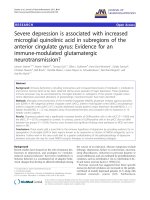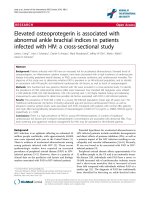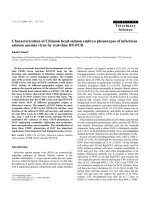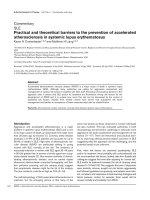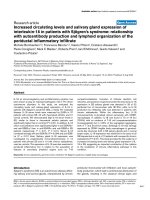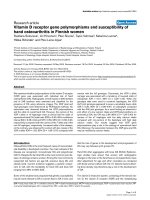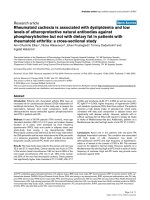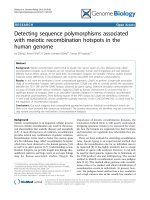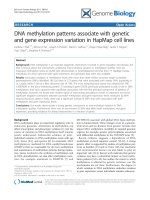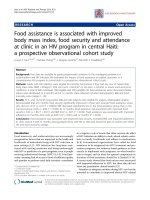Báo cáo y học: " Nebulized heparin is associated with fewer days of mechanical ventilation in critically ill patients: a randomized controlled trial" potx
Bạn đang xem bản rút gọn của tài liệu. Xem và tải ngay bản đầy đủ của tài liệu tại đây (1.04 MB, 10 trang )
RESEARC H Open Access
Nebulized heparin is associated with fewer days
of mechanical ventilation in critically ill patients:
a randomized controlled trial
Barry Dixon
1*
, Marcus J Schultz
2
, Roger Smith
1
, James B Fink
3
, John D Santamaria
1
, Duncan J Campbell
4,5
Abstract
Introduction: Prolonged mechanical ventilation has the potential to aggravate or initiate pulmonary inflammation
and cause lung damage through fibrin deposition. Heparin may reduce pulmon ary inflammation and fibrin
deposition. We therefore assessed whether nebulized heparin improved lung function in patients expected to
require prolonged mechanical ventilation.
Methods: Fifty patients expected to require mechanical ventilation for more than 48 hours were enrolled in a
double-blind randomized placebo-controlled trial of nebulized heparin (25,000 U) or placebo (normal saline) 4 or
6 hourly, depending on patient height. The study drug was continued while the patient remained ventilated to a
maximum of 14 days from randomization.
Results: Nebulized heparin was not associated with a significant improvement in the primary end-point, the
average daily partial pressure of oxygen to inspired fraction of oxygen ratio while mechanically ventilated, but was
associated with improvement in the secondary end-point, ventilator-free days amongst survivors at day 28 (22.6 ±
4.0 versus 18.0 ± 7.1, treatment difference 4.6 days, 95% CI 0.9 to 8.3, P = 0.02). Heparin administration was not
associated with any increase in adverse events.
Conclusions: Nebulized heparin was associated with fewer days of mechanical ventilation in critically ill patients
expected to require prolonged mechanical ventilation. Further trials are required to confirm these findings.
Trial registration: The Australian Clinical Trials Registry (ACTR-12608000121369).
Introduction
Each year in the US, around 500,000 patients require
mechanical ventilation for more than 48 hours [1].
These patients are at high risk of developing lung
damage related to inflammatory mechanisms [2]. Acute
lung injury (ALI), o ne manifestation of inflammatory
mediated lung damage, is present at the onset of pro-
longed mechanical ventilation i n 18% of patients and
subsequently develops in a further 26% of patients [2].
The inflammatory triggers of lung damage include pneu-
monia, sepsis, aspiration, and trauma [1]. Mechanical
ventilation may also damage the lungs through
ventilation-induced lung in jury and ventilator-associated
pneumonia [3-7].
An important inflammatory mechanism of lung
damage is fibrin deposition in the pulmonary microcir-
culation and in the alveolar sacs (hyaline membrane for-
mation). This impairs both a lveolar perfusion and
ventilation [8-12]. Clinical and experimental models
have demonstrated that heparin or other anti-coagulants
reduce fibrin deposition in the lungs and improve clini-
cal outcomes [13-17]. Heparin has othe r actions, includ-
ing reduced pulmonary edema, reduced leukocyte
activation, and inhibition of adhesion of bacteria and
viruses to respiratory surfaces, that may also be benefi-
cial [18-22]. Evidence from large, multi-center, clinical
studies in patients with severe sepsis also suggests that
heparin may improve important clinical outcomes.
Post hoc analysis of three interventional studies found
* Correspondence:
1
Department of Intensive Care, St. Vincent’s Hospital, 41 Victoria Parade,
Fitzroy, Melbourne, Victoria, 3065, Australia
Full list of author information is available at the end of the article
Dixon et al. Critical Care 2010, 14:R180
/>© 2010 Dixon et al.; licensee BioMed Central Ltd. This is an open a ccess article distributed under the terms of the Creative Commons
Attribution License ( which permits unrestricted use, distribution, and reproductio n in
any medium, provided the origina l work is prop erly cited.
that prophylactic subcutaneous heparin administration
was associated with reduced mortality (32% versus 42%,
P = 0.0001) [23-26]. Furthermore, a subsequent prospec-
tive randomized study of subcutaneous heparin in
patients treated with activated protein C for severe sep-
sis also found a trend of lower mortality (28% versus
32%, P = 0.08) [27].
Nebulization of heparin may offer ben efits over sy s-
temic administration because nebulization enhances
delivery to the bronchial tree and the alveolar sacs and
reduces the potential for systemic bleeding associated
with intravenous administration. Furthermore, nebulized
heparin has been shown to reduce levels of coagulation
activation in the lungs both in animal studies and in
patients with ALI [28-31]. In this study, we therefore
assessed whether nebulized heparin improved lung func-
tion in patients expected to require prolonged mechani-
cal ventilation.
Materials and methods
Patients
The study, Can Heparin Reduce Lung Injury (CHARLI),
took place between July 2008 and November 2009. We
studied patients admitted to the intensive care unit
(ICU) of St. Vincent’s Hospital (Melbourne, Australia), a
tertiary-level university-affiliated hospital. The S t. Vin-
cent’s Hospital Human Research Ethics Committee
approved the study. Informed consent was obtained
from the patient, next of kin, or appropriate surrogate
before participation in the study. The study was regis-
tered with the Australi an Clinical Trials Registry
(ACTR-12608000121369).
Patients were included if, owing to primary respiratory
failure or other indications, they were expected to require
invasive mechanical ventilation for more than 48 hours.
They were excluded if they received mechanical ventila-
tion for more than 24 hours prior to enrollment, required
mechanical ventilation for more than 48 hours in a pre-
vious admission to the ICU during the current hospital
admission, or received any of the following at the time of
screening: high-frequency ventilation, extracorporeal
membrane oxygenation, nitric oxide (NO), renal replace-
ment therapy, therapeutic doses of heparin or low-
molecular-weight heparin, warfarin, dro trecogin alpha
activated, or protamine. Also, they were excluded if the
physician was not committed to full supports or they had
abodymassindexof40kg/m
2
or greater, allergy to
heparin (including any history of heparin-induced throm-
bocytopenia), a pulmonary hemorrhage in the previous
3 months, uncontrolled bleeding or a significant bleeding
disorder, an intracranial hemorrhage in the past 12 months
(a clipped subarachnoid aneurysm was acceptable ), or an
epidural catheter in place or likely to be placed in the next
48 hours or were younger than 18 years old.
Study design
CHARLI was a double-blind, randomized, placebo-
controlled trial. Block randomization was performed in
random blocks o f two to eight. Randomization was
stratified by the presence of ALI at enrollment [32].
Allocations were concealed in opaque, sequentially
numbered, sealed envelopes.
Study medication
Heparin and placebo were presented in identical 5-mL
plastic ampules: heparin sodium (porcine mucous)
25,000 U/5 mL (Pfizer, West Ryde, Australia) and pla-
cebo (0.9% sodium chloride; Pfizer). Patients were admi-
nistered 5 mL of s tudy medication every 4 hours or, if
they were less than 165 cm in height, every 6 hours.
The dose was based on data from an earlier study of
patients with ALI [28,29]. Study medication was contin-
ued with a dose regimen of every 6 hours if therapeutic
anti-coagulation was commenced. No dose adjustment
was made for heparin administration for deep venous
thrombosis prophylaxis. The study medication was con-
tinued while the patient remained ventilated and was
given for a maximum of 14 days from randomization.
The study medication was reduced or withheld at the
physicians’ discretion if any of the following occurred:
excessive blood staining of the sputum, other significant
bleeding, a planned surgical procedure, or an excessively
elevated activated partial thromboplastin time (APTT).
Nebulization
Heparin or placebo was nebulized via an Aeroneb Pro
nebulizer (Aerogen Ltd., Galway, Ireland) for 30 min-
utes. The nebulizer generates droplets with a mass med-
ian aerod ynamic diameter of 2.1 μm. The nebuli zer was
placed in the inspiratory limb just before the Y-piece.
An active humidification system was used, and humidifi-
cation was continued during nebulization (Fisher & Pay-
kel Healthcare Ltd., Auckland, New Zealand). A filter
was placed in the expiratory limb of the circuit to pre-
vent the nebulized study drug from damaging the
expiratory valve of the ventilator (BB50TE; Pall Corpora-
tion, Port Washington, NY, USA, or RT019; Fisher &
Paykel Healthcare Ltd .). This filter was changed at least
daily.
Ventilation
A pressure-controlled mode of mechanical ventilation
was used. The target tidal volume was set at not more
than 8 mL/kg of predicted body weight; this was routine
practice at the time of the study. The predicted body
weight was calculated as previously described [7]. Wean-
ing was undertaken with a spontaneous pressure sup-
port mode. The level of pressure support was adjusted
in order to maintain the target tidal volume. NO was
Dixon et al. Critical Care 2010, 14:R180
/>Page 2 of 10
considered if hypoxemia was present despite an inspired
fraction of oxygen (FiO
2
)ofmorethan60%andaposi-
tive end-expiratory pressure (PEEP) of more than 10 cm
H
2
O or if pulmonary hypertension with hemodyamic
instabili ty was present. Patients were considered suitable
for extubation if they w ere cooperative and hemodyna-
mically stable with an oxygen saturation of at least 95%
while ventilated on pressure support of not more than
10 cm H
2
O, PEEP of not more than 5 cm H
2
O, and
FiO
2
of not more tha n 50%. Patients who were not sui-
table for extubation after 4 days of mechanical ventila-
tion and who had not demonstrated clinical
improvement were considered for tracheostomy. Routine
tracheostomy insertion was undertaken, using a percuta-
neous t echnique, by t he treating intensive care
physician.
Outcomes
The primary outcome was the average daily ratio of par-
tial pressure of oxygen to FiO
2
(PaO
2
/FiO
2
) while the
patient remained ventilated for a maximum of 14 days
from randomization. Secondary outcomes included ven-
tilator-free days among surviving patients at day 28, the
development of ALI following enrollme nt, tracheostomy
rate, days free of vasopressor and acute renal failure
among survivors at day 28, lengths of stay in ICU and
hospital, and mortality at days 28 and 60.
Anti-coagulant effects of heparin
Daily APPT levels were recorded to assess the systemic
effects of nebulized heparin. Pulmonary lavage marke rs
of coagulation activation (thrombin-antithrombin com-
plex [TAT] and D-dimer) were also measured.
Pulmonary lavage
Levels in pulmonary lavage fluid of inflammatory media-
tors (tumor necrosis factor-alpha [TNF-a], interleukin
[IL]-6, and IL-8), of lung damage (surfactant protein-D
[SP-D], Clara cell protein-16 [CC-16], and recept or for
advanced glycation end-products [RAGE]), and TAT
and D-dimers were measured at baseline and on study
days 1, 2, 4, 8, and 14 if the patient remained mechani -
cally ventilated and sedated. In addition, cultures were
undertaken on the pulmonary lavage samples.
Data collection
The PaO
2
/FiO
2
ratio and oxygenation index (FiO
2
mul-
tiplied by the mean airway pressure divided b y the
PaO
2
) were measured each day at 4 a.m. No changes in
the ventilator settings or the patient’s position were per-
mitted for the 10 minutes before this measurement. A
non-bronchoscopic pulmonary lavage was performed
using a suction catheter, as previously described [33].
The recovered fluid was centrifuged at 1,500g for
10 minutes at 4°C. The supernatant was collected and
stored at -80°C until measurements were performed.
Levels of TAT, D-dimer, TNF, IL-6, IL-8, RAGE, CC-
16, and SP-D were assessed by enzyme-linked immuno-
sorbent assay as previously described [30,34].
Demographic data were collected on study entry, and
ventilation parameters, clinical and radiological data,
sputum character, medication usage, and adverse events,
including blood-stained sputum or frank blood in spu-
tum and red cell transfusions, were recorded daily while
the patient remained mechanically ventilated. Ventila-
tor-free days was defined as the number of days patients
were breathing w ithout mechanical venti lation during
the first 28 days. Dev elopment of ALI was defined using
the consensus criteria [32]. Vasopressor usage was
defined by the administration of any of the following:
dop amine, dobutamine, norepinephrine, or epinephrine.
Renal failure was defined as a serum creatinine of
greater than 300 μmol/L or urine output of less than
500 mL per day or renal replacement therapy for acute
renal impairment. Respiratory failure was defined as the
acute requirement for mechanical ventilation primarily
due t o ALI, pneumonia, influenza, aspiration, exacerba-
tion of chronic obstructive airway disease, or other
acute lung disorder.
Statistical analysis
On the basis of previous data from a trial of intravenous
heparin to limit lung injury in patients undergoing car-
diac surgery, the s tudy was powered to demonstrate an
improvement in the average daily PaO
2
/FiO
2
ratio from
250 to 300 mm Hg over the period of mechanical venti-
lation, assuming a standard deviation (SD) of 50, alpha
= 0.05, and power = 0. 8 [35]. Data were analyzed on an
intention-to-treat basis. Data are expressed as mean ±
standard error of the mean or SD, or as median with
interquartile range, and were compared using Student t
test or the median test where appropriate. Categorical
variables were compared using chi-square tests or Fisher
exact tests where appropriate. The rate of freedom from
mechanical ventilation was analyzed according to the
Kaplan-Meier method and the results were c ompared
with the log-rank test. All reported P values were two-
sided. A P value of 0.05 or less was considered to indi-
cate statistical significance. Analyses were conducted
with JMP software (SAS Institute Inc., Cary, NC, USA).
Results
Enrollment data
Screening and enrollments are shown in Figure 1.
Twenty-five patients were randomly assigned to nebu-
lized heparin, and 25 were randomly assigned to placebo.
All patients received the allocated treatment and were
included in the final an alysis. The baseline characteristics
Dixon et al. Critical Care 2010, 14:R180
/>Page 3 of 10
of the two groups, including t he APACHE II (Acute Phy-
siology and Chronic Health Evaluation II) score and the
proportion of patients with respiratory failure or ALI and
APTT levels, wer e similar (Table 1). In addition, the
respiratory physiological variables at enrollment were
similar between groups (Figure 2). A trend of increased
positive respiratory cultures in the placebo group was
present at baseline (11/25 [44%] versus 5/25 [20%], rela-
tive risk 0.5, 95% confidence interval [CI] 0.2 to 1.2,
P = 0.07) (Table 2).
Clinical outcomes
The primary end-point, the average daily PaO
2
/FiO
2
ratio while ventilated, was similar in the heparin and
placebo groups (194.2 ± 62.8 versus 187 ± 38.6 mm Hg,
mean difference 7.2, 95% CI -22.8 to 37.1, P =0.6).
Though not statistically significant, the PaO
2
/FiO
2
ratio
levels were higher from day 3 in the h eparin group. In
addition, NO was used less frequently in the heparin
group (0/25 [0%] versus 5/25 [19%], relative risk 0.8,
95% CI 0.7 to 0.97, P =0.05).ThePaO
2
/FiO
2
ratio
levels and other respiratory variables over the first 7
days are presented in Figure 2.
Heparin administration was associated with a higher
number of ventila tor-free days among surviv ors at da y
28 (22.6 ± 4.0 versus 18.0 ± 7.1, treatment difference
4.6, 95% CI 0.9 to 8.3, P = 0.02). Similarly, when t he
composite method was used to calculate ventilator-free
days (patients who died were assigned 0 ventilator-free
days), there was a diff erence between gro ups (22 [14 to
26] versus 19 [6 to 22], P <0.05). The rate of freedom
from mechanical ventilation among survivors at day 28
was higher in the heparin group (P = 0.01, log-rank test)
(Figure 3). The number of tracheostomies tended to be
lower in the heparin group (7/25 [28%] versus 12/25
[48%], relative risk 0.66, 95% CI 0.39 to 1.1, P =0.1).
A tracheostomy, if required, was undertak en an average
of 5 ± 3 days after enrollment. There was also a trend
of reduced development of ALI following enrollment in
the heparin group (0/21 [0%] versus 4/21 [19%], relative
risk 0.84, 95% CI 0.7 to 1.0, P = 0.1).
The number of vasopressor-free days among survivors
at day 28 (24.7 ± 3.2 versus 22.0 ± 7.0 days, difference
-2.7, 95% CI -6.2 to 0.8, P = 0.12) and the number of
renal failure-free days among survivors at day 28 (28 [28
to 28] versus 28 [26.5 to 28] days, P = 0. 09) were higher
in the heparin group but did not reach statistical signifi-
cance. The ICU and hospital lengths of stay (9.4 ± 7.4
versus 14.0 ± 13.1 days, difference -4.7, 95% CI -11.4 to
2.1, P = 0.2, and (24 [15 to 36.5] versus 27 [16.0 to 52.5]
days, P = 0.4) and mortality at days 28 and 60 (20% ver-
sus 16%, P = 0.7, and 28% versus 20%, P =0.5)were
similar in the two groups.
Figure 1 Enrollment and outcomes.
Table 1 Baseline characteristics
Baseline characteristics Placebo
N =25
Heparin
N =25
Age in years, mean ± SD 55.5 ± 17.0 56.0 ± 16.5
Males, number (percentage) 14 (56) 18 (72)
APACHE II score, mean ± SD 19.4 ± 7.2 20.2 ± 6.1
Respiratory failure
a
, number (percentage) 17 (68) 14 (56)
Acute lung injury, number (percentage) 4 (16) 4 (16)
Aspiration, number (percentage) 2 (8) 2 (8)
Vasopressor use, number (percentage) 16 (64) 13 (52)
APTT, seconds 41.1 38.0
Primary diagnosis, number (percentage)
Community-acquired pneumonia 9 (36) 7 (28)
Hospital-acquired pneumonia 3 (12) 2 (8)
H1N1 influenza 1 (4) 2 (8)
Chronic obstructive airway disease 1 (4) 1 (4)
Post cardiac arrest 1 (4) 2 (8)
Cardiac failure 2 (8) 1 (4)
Meningitis 1 (4) 0
Uncontrolled seizures 0 1 (4)
Subarachnoid hemorrhage 1 (4) 1 (4)
Cardiac surgery 3 (12) 4 (16)
Thymectomy 0 1 (4)
perforated duodenal ulcer 1 (4) 0
Cervical fracture 0 1 (4)
Drug intoxication 2 (8) 2 (8)
Admission source, number (percentage)
Emergency department 13 (52) 9 (36)
Operation theater 4 (16) 5 (20)
Hospital ward 6 (24) 8 (32)
Other hospital 2 (8) 3 (12)
a
Denotes acute requirement for mechanical ventilation primarily due to acute
lung injury, pneumonia, influenza, aspiration, exacerbation of chronic
obstructive airway disease, or other acute lung disorder. APACHE II, Acute
Physiology and Chronic Health Evaluation II; APPT, activated partial
thromboplastin time; SD, standard deviation.
Dixon et al. Critical Care 2010, 14:R180
/>Page 4 of 10
Figure 2 Respirat ory values over the first 7 days of the study. There were no significant differences between groups in the average daily
levels of the ratio of partial pressure of arterial oxygen to fraction of inspired oxygen (PaO
2
/FiO
2
), predicted body weight (PBW), peak inspiratory
pressure (PIP), positive end-expiratory pressure (PEEP), partial pressure of arterial carbon dioxide (PaCO
2
), or minute ventilation over the course of
the study period (days on which the patient remained mechanical ventilation to a maximum of 14 days from randomization). The numbers of
patients who were mechanically ventilated are as follows: day 0 placebo (25) and heparin (25), day 1 placebo (24) and heparin (25), day 3
placebo (21) and heparin (15), day 5 placebo (19) and heparin (11), and day 7 placebo (13) and heparin (7). Graphs represent mean ± standard
error of the mean.
Dixon et al. Critical Care 2010, 14:R180
/>Page 5 of 10
Anti-coagulant effects of heparin
The maximum increase in the APTT from baseline
levels over t he study period was higher in the heparin
group(4[1to13]versus0[-1to4]seconds,P = 0.02).
This analysis excluded patients administered therapeutic
heparin. Pulmonary lava ge levels o f TAT and D-dimer
were similar in the two groups at base line and following
enrollment (Table 2).
Respiratory cultures and pulmonary inflammatory
markers
The proportion of patients with new positive respiratory
cultures following enrollment was similar in the two
groups (Table 3). Levels of IL-6, IL-8, TNF, SD-P, CC-
16, and RAGE in pulmonary lavage fluid were also simi-
lar in the two groups at baseline and on each day that
samples were taken following enrollment (Table 2).
Other medication
Therapeutic doses of sy stemic heparin were admini s-
tered to 24% of patients in the heparin group and 32%
in the placebo group following enrollment. Heparin for
deep venous thrombosis prophylaxis was administered
to 64% of patients in the heparin group and 48% in the
placebo group prior to enrollment and to 84% of
patients in both groups following enrollment. Antibio-
tics, steroids, and other nebulized medications were
used to a similar extent in t he two groups (Supplement
in Additional file 1).
Safety and tolerability
On average, each patient in the heparin group was
administered 22 ± 15 doses and each patient in the pla-
cebo group was administered 37 ± 20 doses. The study
drugs were well tolerated, with only 6% of scheduled
doses withheld in the heparin group and 4% in the pla-
cebo group during the study period (Table 4). The per-
centages of days during the study period patients had
blood-stained sputum were similar in the heparin and
placebo groups (41 ± 39 versus 31 ± 28). Blood product
usage was also similar for the two groups, with 7
patients (28%) transfused over the study period in t he
heparin group and 10 patients (40%) transfused in the
placebo group. No patients had blood loss or transfusion
requirements attributable t o the stu dy medication. One
patient in the heparin group had a marked increase for
Table 2 Pulmonary lavage values
Baseline Day 1 Day 2 Day 4
Placebo
N =25
Heparin
N =25
Placebo
N =24
Heparin
N =24
Placebo
N =22
Heparin
N =20
Placebo
N =18
Heparin
N =14
TAT, μg/L 13.9 (6.2-37.9) 8.7 (3.5-30.0) 7.8 (4.9-20.7) 8.1 (3.5-17.3) 9.3 (3.9-15.7) 7.3 (3.1-20.3) 7.9 (4.3-11.0) 7.2 (2.6-18.4)
D-dimer,
mg/L
3.1 ± 6.3 2.4 ± 7.5 5.4 ± 11.3 2.8 ± 7.8 1.3 ± 2.0 0.67 ± 1.1 0.67 ± 1.1 0.52 ± 0.54
IL-6, pg/mL 235 (44-1,699) 187 (34-961) 173 (71-547) 182 (58-589) 132 (36-497) 105 (27-478) 90 (34-313) 60 (23-227)
IL-8, pg/mL 546 (219-1,383) 559 (198-
11,949)
667 (255-2,633) 1,396 (333-
6,009)
874 (381-1,901) 1328 (369-
2,895)
691 (234-1,307) 1,035 (246-
1,812)
TNFa, pg/
mL
11.8 ± 19.5 9.3 ± 12.7 7.3 ± 10.2 4.9 ± 7.3 5.9 ± 8.9 6.8 ± 13.3 7.9 ± 9.9 6.4 ± 7.9
SP-D, ng/mL 162.6 (44.7-
602.3)
309.7 (51.7-
805.9)
305.1 (65.3-
662.1)
210.5 (36.0-
901.5)
153.8 (82.7-
823.2)
119.2 (78.4-
368.1)
136.1 (85.5-
309.4)
176.6 (43.8-
399.6)
CC-16, ng/
mL
180.0 ± 148.6 207.2 ± 137.8 176.8 ± 155.7 172.4 ± 123.7 225.5 ± 148.6 186.5 ± 150.0 229.8 ± 142.6 207.4 ± 237.9
RAGE, pg/
mL
2,015 ± 3,607 3,170 ± 5,428 3,717 ± 11,072 3,320 ± 6,472 1,564 ± 3,273 1,975 ± 3,633 563 ± 1,369 936 ± 1,737
Values are presented as median and interquartile range (there were no statistical differences between groups, and comparisons were undertaken at baseline and
study days 1, 2, and 4) or as mean ± standard deviation. CC-16, Clara cell protein-16; IL, interleukin; RAGE, receptor for advanced glycation end-products; SP-D,
surfactant protein-D; TAT, thrombin-antithrombin complex; TNFa, tumor necrosis factor-alpha.
Figure 3 Rate of freedom from mechanical ventilation. Over the
first 28 days among surviving patients, the rate of freedom from
mechanical ventilation was higher in patients administered heparin.
Median times of ventilation were 5 days in the heparin group (n =20)
and 8 days in the placebo group (n =21)(P = 0.01) (log-rank test).
Dixon et al. Critical Care 2010, 14:R180
/>Page 6 of 10
3 days in the APTT to more than 150 seconds; this cor-
rected with temporary withdrawal of the study
medication.
Subgroup analysis by Forest plot
We conducted a post hoc subgroup analysis to examine
the effects of enrollment characteristics on the ventila-
tor-free days among survivors at day 28. The magni-
tude of the treatment effect of heparin was similar
regardless of whether respiratory failure, ALI, or a
positive respiratory microbiological test was present at
enrollment (Figure 4).
Discussion
In this double-blind, randomized, placebo-controlled
trial of nebulized heparin in crit ically ill patients
expected to require prolonged mechanical ventilation,
we found that nebulized heparin was associated with
fewer days of mechanical ventilation. We found no dif-
ference between groups in the primary end-point, the
average daily PaO
2
/FiO
2
ratio while ventilated. The
more rapid rate of extubation in the heparin group lim-
ited the power of the study to demonstrate a difference
in this end-point, as the daily PaO
2
/FiO
2
ratio was mea -
sured only if the patient was ventilated. Consequently, it
wasnotpossibletocontinuetocollectthePaO
2
/FiO
2
ratio data from the most impr oved patients. The daily
changes in the PaO
2
/FiO
2
ratio support this rationale
with higher levels of oxygenation over the first 7 days in
the heparin group (Figure 2). In addition, the increased
use of NO following enrollment in the placebo group
(20%) compared with the heparin group (0%) indicates
that oxygenation was less problematic in the heparin
group.
Whereas we found no statistically significant differ-
ence in the PaO
2
/FiO
2
ratio, we did find a significant
improvement in the clinically important end-point of
ventilator-free days. One mechanism by which nebulized
heparin may improve the potential for successful extu-
bation is through reducing fibrin deposition in the pul-
monary microcirculation an d the alveolar sacs (hyaline
membrane). Recent randomized studies in patients with
acute pulmonary inflammation following cardiac surgery
demonstrated that intravenous heparin significantly
reduced histological and other evidence of pulmonary
microvascular thrombosis [13,35]. Animal models of
sepsis and ALI have also demonstrated reduced micro-
vascular thrombosis and hyaline membrane formation
with both intravenous and nebulized heparin
[16,17,36-39]. Fibrin deposition creates a barrier to gas
exchange by reducing both alveolar perfusion and venti-
lation [8-12]. Pulmonary microvascular thrombosis may
also cause ischemic damage of alveolar tissue and right
Table 3 Respiratory microbiology
Positive culture at enrollment P value New positive culture following enrollment P value
Placebo
N =25
Heparin
N =25
Placebo
N =25
Heparin
N =25
Respiratory cultures, number (percentage)
Pathogen detected 11 (44) 5 (20) 0.07 12 (48) 9 (36) 0.4
Gram-positive 4 (16) 1 (4) 0.4 1 (4) 2 (8) 0.5
Gram-negative 5 (20) 1 (4) 0.2 6 (24) 5 (20) 0.7
Yeast/fungus 3 (12) 1 (4) 0.6 7 (28) 3 (7) 0.2
Legionella pneumonia 1 (4) 0 1 0 0
H1N1 polymerase chain reaction 1 (4) 2 (8) 1 0 0
Pulmonary lavage was undertaken at enrollment and on study days 1, 2, 4, 8, and 14 if the patient remained ventilated and sedated.
Table 4 Study drug safety and tolerability
Placebo
N =25
Heparin
N =25
P
value
Percentage of scheduled doses
withheld
3.8 ± 9.2 5.8 ± 9.5 0.5
Reasons for withholding
Blood-stained sputum 1 (4) 6 (24) 0.1
Prolonged APTT 1 (4) 3 (12) 0.6
Suspected HIT 0 1 (4) 1
Confirmed HIT 1 (4) 0 1
Invasive procedure 3 (12) 0 0.2
Other 4 (16) 2 (8) 0.7
Percentage of days during study period
with
Blood-stained sputum 31 ± 28 41 ± 39 0.3
Frank blood in sputum 2.5 ± 9 7.0 ± 21 0.3
Purulent sputum
a
62 ± 25 61 ± 35 1
Red cell transfusion
Volume transfused per day (mls) 0 (0-57) 0 (0-85) 0.9
Patients transfused 10 (40) 7 (28) 0.4
Abnormal APTT
b
(> 40 seconds) 5/17 (29) 11/19
(58)
0.08
a
Denotes sputum reported as yellow, green, dirty, or purulent.
b
Patients on
therapeutic heparin were excluded from this analysis. Values other than
P values are presente d as mean ± standard deviation, as median (interquartile
range), or as number (percentage). APPT, activated partial thromboplastin
time; HIT, heparin-induced thrombocytopenia.
Dixon et al. Critical Care 2010, 14:R180
/>Page 7 of 10
heart strain through increased right-ventricle after-load
[23,40,41]. Furthermore, fibrin is a proinflammatory
mediator that plays an important role in leukocyte
recruitment to inflamed tissues, and this may also
damage lung tissues [42].
We assessed the anti-coagulant effects of nebulized
heparin on the lungs by measuring systemic APTT
levels and also markers of coagulation act ivation in pul-
monary lavage fl uid. Nebulized heparin was associated
with a systemic anti-coagulant effect with a greater
increase in A PTT levels compared with placebo. The
local anti-coagulant effects of nebulized heparin in the
alveolar sacs and microcirculation of the lungs therefore
would be much greater. Nebulized heparin is cleared
slowly from the lungs, and 40% was still present in the
lungs 24 hours after nebulization of a single dose
[43,44]. It was surprising, therefore, that the pulmonary
lavage markers of coagulation activation were not lower
in the heparin group. We believe that this finding
reflects methodological limitations. In an earlier clinical
study of patients with ALI, nebulized heparin did signifi-
cantly reduce coagulation activation in the lungs [28]. In
this study, bronchoscopic methods were used to obtain
alveolar lavage fluid, whereas in the present study, non-
bronchoscopic methods (a suction catheter placed in the
bronchial tree) were used to obtain pulmonary lavage
fluid. A r ecen t comparison of the two techniques found
that non-bronchoscopic methods did not provide an
accurate assessment of alveolar levels of lung inflamm a-
tory markers [45]. This methodological limitation may
also be a factor in the finding of similar levels of inflam-
matory mediators (IL-6, IL-8, and TNF) and markers of
lung damage (SP-D, CC-16, and RAGE) in the pulmon-
ary lavage fluid of the two groups [46].
Previous studies have suggested that heparin may inhi-
bit growth of bacteria and viruses in the lungs through
limiting their adhesion to respiratory surfaces [20-22].
We did not find evidence to support this, and ther e were
similar numbers of new pos itive bacterial cultures in pul-
monary lavage fluid in both groups following enrollment.
Safety and adverse events
Heparin n ebulization w as safe and not associated with
serious adver se events, even in patients co-administered
systemic heparin. The study drugs were well tole rated,
and only 6% of scheduled doses were withheld in the
heparin group and 4% of scheduled doses were withheld
in the placebo group. The percentage of study days with
blood-stained sputum was relatively common but was
not significantly increased in the heparin group. Blood
product usage was also similar, and no blood transfusion
was attributable to the stud y medication. The maximum
change in the APTT from baseline levels over the study
period was higher in the heparin group. This increase
was not associated with any adverse clinical conse-
quences. In one patient, the APTT level exceeded 150
seconds. This corrected by omitting the nebulized
heparin for 24 hours. After resuming heparin at a lower
dose, the APPT levels remained stable.
Limitations and strengths
The indications for mechanical ventilation were rela-
tively broad. At enrollment, 62% of patients were venti-
lated for respiratory failure, whereas the remaining
patients were ventilated for other reasons, including car-
diac failure and coma. However, the proportion of
patients ventilated for respiratory failure or ALI was
similar in the two groups. Furthermore, post hoc
Figure 4 Forest plot of the trea tment effe ct of nebulized hep arin on ventilator-free days among survivors at day 28 by baseline
characteristics. The microbiological tests included culture of pulmonary lavage fluid and polymerase chain reaction for H1NI. CI, confidence interval.
Dixon et al. Critical Care 2010, 14:R180
/>Page 8 of 10
subgroup analysis indicated that the magnitude of the
treatment effect was similar regardless o f the indication
for mechanical venti lati on and of whether ALI was pre-
sent at enrollment. Another potential limitation of the
study was that it was undertaken in a single center. This
raises questions regarding whether our findings can be
appliedtoothersettings.Thestudy,however,had
important strengths, i ncluding the fact that all patients
were exposed to prolonged mechanical ventilation and
therefore the associated risks of lung damage. In addi-
tion, the double-blind placebo design and randomization
of patients limited the potential for bias.
Conclusions
Nebulized heparin was associated with fewer days of
mechanical ventilation in patie nts expected to require
prolonged mechanical ventilation. Further trials are
required to confirm these findings.
Key messages
• Nebulized heparin may reduce the duration of
mechanical ventilation in critically ill patients
expected to require prolonged mechanical
ventilation.
Additional material
Additional file 1: Supplement. A table of medication.
Abbreviations
ALI: acute lung injury; APTT: activated partial thromboplastin time; CC-16:
Clara cell protein-16; CHARLI: Can Heparin Reduce Lung Injury; CI:
confidence interval; FiO
2
: inspired fraction of oxygen; ICU: intensive care unit;
IL: interleukin; NO: nitric oxide; PaO
2
: partial pressure of oxygen; PEEP:
positive end-expiratory pressure; RAGE: receptor for advanced glycation end-
products; SD: standard deviation; SP-D: surfactant protein-D; TAT: thrombin-
antithrombin complex; TNF: tumor necrosis factor.
Acknowledgements
We wish to thank Karl Askew and Joe Walters, who greatly assisted in the
randomization of patients and study drug preparation. This work was
supported by a grant from the Australian Intensive Care Foundation. The
funding body played no role in study design; in collection, analysis, or
interpretation of data; in writing of the manuscript; or in the decision to
submit the manuscript for publication.
Author details
1
Department of Intensive Care, St. Vincent’s Hospital, 41 Victoria Parade,
Fitzroy, Melbourne, Victoria, 3065, Australia.
2
Department of Intensive Care
Medicine & Laboratory of Experimental Intensive Care and Anesthesiology,
The Academic Medical Center, Meibergdreef 9, 1105 AZ, Amsterdam, The
Netherlands.
3
Division of Respiratory Therapy, School of Health Professions,
College of Health and Human Sciences, Georgia State University, 424 One
Park Place South, Atlanta, GA 30302-4019, USA.
4
St. Vincent’s Institute of
Medical Research, 9 Princes Street, Fitzroy, Melbourne, Victoria, 3065,
Australia.
5
Department of Medicine, The University of Melbourne, Clinical
Sciences Building, 29 Regent Street, Fitzroy, Melbourne, Victoria, 3065,
Australia.
Authors’ contributions
BD and RS participated in the study design, data gathering, interpretation,
statistical analysis, and writing the first draft and all revisions of the
manuscript. MJS participated in the study design, laboratory analysis,
interpretation, and writing the first draft and all revisions of the manuscript.
JBF participated in the study design. DJC and JDS participated in the study
design and revisions of the manuscript. All authors read and approved the
final manuscript.
Competing interests
St. Vincent’s Hospital has applied for a patent relating to nebulized heparin,
and BD and RS could benefit from this application. The other authors
declare that they have no competing interests.
Received: 27 September 2010 Accepted: 11 October 2010
Published: 11 October 2010
References
1. Rubenfeld GD, Caldwell E, Peabody E, Weaver J, Martin DP, Neff M, Stern EJ,
Hudson LD: Incidence and outcomes of acute lung injury. N Engl J Med
2005, 353:1685-1693.
2. Gajic O, Dara SI, Mendez JL, Adesanya AO, Festic E, Caples SM, Rana R, St
Sauver JL, Lymp JF, Afessa B, Hubmayr RD: Ventilator-associated lung
injury in patients without acute lung injury at the onset of mechanical
ventilation. Crit Care Med 2004, 32:1817-1824.
3. Parker JC, Hernandez LA, Peevy KJ: Mechanisms of ventilator-induced lung
injury. Crit Care Med 1993, 21:131-143.
4. Kollef M, Pittet D, Sanchez Garcia M, Chastre J, Fagon JY, Bonten M, Hyzy R,
Fleming TR, Fuchs H, Bellm L, Mercat A, Manez R, Martinez A, Eggimann P,
Daguerre M, Luyt CE: A randomized double-blind trial of iseganan in
prevention of ventilator-associated pneumonia. Am J Respir Crit Care Med
2006, 173:91-97.
5. Schultz MJ, Millo J, Levi M, Hack CE, Weverling GJ, Garrard CS, van der
Poll T: Local activation of coagulation and inhibition of fibrinolysis in the
lung during ventilator associated pneumonia. Thorax 2004, 59:130-135.
6. Determann RM, Royakkers A, Wolthuis EK, Vlaar AP, Choi G, Paulus F,
Hofstra JJ, de Graaff MJ, Korevaar JC, Schultz MJ: Ventilation with lower
tidal volumes as compared with conventional tidal volumes for patients
without acute lung injury: a preventive randomized controlled trial. Crit
Care 2010, 14:R1.
7. Ventilation with lower tidal volumes as compared with traditional tidal
volumes for acute lung injury and the acute respiratory distress
syndrome. The Acute Respiratory Distress Syndrome Network. N Engl J
Med 2000, 342:1301-1308.
8. Nuckton TJ, Alonso JA, Kallet RH, Daniel BM, Pittet JF, Eisner MD,
Matthay MA: Pulmonary dead-space fraction as a risk factor for death in
the acute respiratory distress syndrome. N Engl J Med 2002,
346:1281-1286.
9. Idell S: Coagulation, fibrinolysis, and fibrin deposition in acute lung
injury. Crit Care Med 2003, 31:S213-220.
10. Yoshikawa T, Tanaka KR, Guze LB: Infection and disseminated intravascular
coagulation. Medicine 1971, 50:237-258.
11. Bone RC, Francis PB, Pierce AK: Intravascular coagulation associated with
the adult respiratory distress syndrome. Am J Med 1976, 61:585-589.
12. Tomashefski JF Jr, Davies P, Boggis C, Greene R, Zapol WM, Reid LM: The
pulmonary vascular lesions of the adult respiratory distress syndrome.
Am J Pathol 1983, 112:112-126.
13. Dixon B, Opeskin K, Stamaratis G, Nixon I, Yi M, Newcomb AE, Rosalion A,
Zhang Y, Santamaria JD, Campbell DJ: Pre-operative heparin reduces
pulmonary microvascular fibrin deposition following cardiac surgery.
Thromb Res 2010.
14. Carraway MS, Welty-Wolf KE, Miller DL, Ortel TL, Idell S, Ghio AJ,
Petersen LC, Piantadosi CA: Blockade of tissue factor: treatment for organ
injury in established sepsis.
Am J Respir Crit Care Med 2003, 167:1200-1209.
15. Taylor FB Jr, Emerson TE Jr, Jordan R, Chang AK, Blick KE: Antithrombin-III
prevents the lethal effects of Escherichia coli infusion in baboons. Circ
Shock 1988, 26:227-235.
16. Murakami K, McGuire R, Cox RA, Jodoin JM, Bjertnaes LJ, Katahira J,
Traber LD, Schmalstieg FC, Hawkins HK, Herndon DN, Traber DL: Heparin
Dixon et al. Critical Care 2010, 14:R180
/>Page 9 of 10
nebulization attenuates acute lung injury in sepsis following smoke
inhalation in sheep. Shock 2002, 18:236-241.
17. Cox CS Jr, Zwischenberger JB, Traber DL, Traber LD, Haque AK,
Herndon DN: Heparin improves oxygenation and minimizes barotrauma
after severe smoke inhalation in an ovine model. Surg Gynecol Obstet
1993, 176:339-349.
18. Darien BJ, Fareed J, Centgraf KS, Hart AP, MacWilliams PS, Clayton MK,
Wolf H, Kruse-Elliott KT: Low molecular weight heparin prevents the
pulmonary hemodynamic and pathomorphologic effects of endotoxin in
a porcine acute lung injury model. Shock 1998, 9:274-281.
19. Weber JR, Angstwurm K, Rosenkranz T, Lindauer U, Freyer D, Burger W,
Busch C, Einhaupl KM, Dirnagl U: Heparin inhibits leukocyte rolling in pial
vessels and attenuates inflammatory changes in a rat model of
experimental bacterial meningitis. J Cereb Blood Flow Metab 1997,
17:1221-1229.
20. Thomas R, Brooks T: Common oligosaccharide moieties inhibit the
adherence of typical and atypical respiratory pathogens. J Med Microbiol
2004, 53:833-840.
21. Idanpaan-Heikkila I, Simon PM, Zopf D, Vullo T, Cahill P, Sokol K,
Tuomanen E: Oligosaccharides interfere with the establishment and
progression of experimental pneumococcal pneumonia. J Infect Dis 1997,
176:704-712.
22. Bryan R, Feldman M, Jawetz SC, Rajan S, DiMango E, Tang HB, Scheffler L,
Speert DP, Prince A: The effects of aerosolized dextran in a mouse model
of Pseudomonas aeruginosa pulmonary infection. J Infect Dis 1999,
179:1449-1458.
23. Dixon B: The role of microvascular thrombosis in sepsis. Anaesth Intensive
Care 2004, 32:619-629.
24. Warren BL, Eid A, Singer P, Pillay SS, Carl P, Novak I, Chalupa P,
Atherstone A, Penzes I, Kubler A, Knaub S, Keinecke HO, Heinrichs H,
Schindel F, Juers M, Bone RC, Opal SM: Caring for the critically ill patient.
High-dose antithrombin III in severe sepsis: a randomized controlled
trial. JAMA 2001, 286:1869-1878.
25. Abraham E, Reinhart K, Opal S, Demeyer I, Doig C, Rodriguez AL, Beale R,
Svoboda P, Laterre PF, Simon S, Light B, Spapen H, Stone J, Seibert A,
Peckelsen C, De Deyne C, Postier R, Pettila V, Artigas A, Percell SR, Shu V,
Zwingelstein C, Tobias J, Poole L, Stolzenbach JC, Creasey AA: Efficacy and
safety of tifacogin (recombinant tissue factor pathway inhibitor) in
severe sepsis: a randomized controlled trial. JAMA 2003, 290:238-247.
26. Bernard GR, Vincent JL, Laterre PF, LaRosa SP, Dhainaut JF, Lopez-
Rodriguez A, Steingrub JS, Garber GE, Helterbrand JD, Ely EW, Fisher CJ Jr:
Efficacy and safety of recombinant human activated protein C for severe
sepsis. N Engl J Med 2001, 344:699-709.
27. Levi M, Levy M, Williams MD, Douglas I, Artigas A, Antonelli M, Wyncoll D,
Janes J, Booth FV, Wang D, Sundin DP, Macias WL: Prophylactic heparin in
patients with severe sepsis treated with drotrecogin alfa (activated). Am
J Respir Crit Care Med 2007, 176:483-490.
28. Dixon B, Schultz MJ, Hofstra JJ, Campbell DJ, Santamaria JD: Nebulised
heparin reduces pulmonary coagulation activation in acute lung injury.
Crit Care 2010, 14:445.
29. Dixon B, Santamaria JD, Campbell DJ: A phase 1 trial of nebulised heparin
in acute lung injury. Crit Care 2008, 12:R64.
30. Hofstra JJ, Cornet AD, de Rooy BF, Vlaar AP, van der Poll T, Levi M, Zaat SA,
Schultz MJ: Nebulized antithrombin limits bacterial outgrowth and lung
injury in Streptococcus pneumoniae pneumonia in rats. Crit Care 2009,
13:R145.
31. Hofstra JJ, Vlaar AP, Cornet AD, Dixon B, Roelofs JJ, Choi G, van der Poll T,
Levi M, Schultz MJ: Nebulized anticoagulants limit pulmonary
coagulopathy, but not inflammation, in a model of experimental lung
injury. J Aerosol Med Pulm Drug Deliv 2010, 23:105-111.
32. Bernard GR, Artigas A, Brigham KL, Carlet J, Falke K, Hudson L, Lamy M,
Legall JR, Morris A, Spragg R: The American-European Consensus
Conference on ARDS. Definitions, mechanisms, relevant outcomes, and
clinical trial coordination. Am J Respir Crit Care Med 1994, 149:818-824.
33. Millo JL, Schultz MJ, Williams C, Weverling GJ, Ringrose T, Mackinlay CI, van
der Poll T, Garrard CS: Compartmentalisation of cytokines and cytokine
inhibitors in ventilator-associated pneumonia. Intensive Care Med 2004,
30:68-74.
34. Determann RM, Wolthuis EK, Choi G, Bresser P, Bernard A, Lutter R,
Schultz MJ: Lung epithelial injury markers are not influenced by use of
lower tidal volumes during elective surgery in patients without
preexisting lung injury. Am J Physiol Lung Cell Mol Physiol 2008, 294:
L344-350.
35. Dixon B, Campbell DJ, Santamaria JD: Elevated pulmonary dead space
and coagulation abnormalities suggest lung microvascular thrombosis in
patients undergoing cardiac surgery. Intensive Care Med 2008,
34:1216-1223.
36. Good RTL: Studies on the generalized Shwartzman reaction IV.
prevention of the local and generalized Shwartzman reaction by
heparin. J Exp Med 1953, 97:871-888.
37. Margaretten W, McKay D, Phillips LL: The effect of heparin on endotoxin
shock in the rat. Am J Pathol 1967, 51:61-68.
38. Coalson JJ, Benjamin B, Archer LT, Beller B, Gilliam CL, Taylor FB,
Hinshaw LB: Prolonged shock in the baboon subjected to infusion of E.
coli endotoxin. Circ Shock 1978, 5:423-437.
39. Abubakar K, Schmidt B, Monkman S, Webber C, de SD, Roberts R: Heparin
improves gas exchange during experimental acute lung injury in
newborn piglets. Am J Respir Crit Care Med 1998, 158:1620-1625.
40. Cooper JR Jr, Abrams J, Frazier OH, Radovancevic R, Radovancevic B,
Bracey AW, Kindo MJ, Gregoric ID: Fatal pulmonary microthrombi during
surgical therapy for end-stage heart failure: possible association with
antifibrinolytic therapy. J Thorac Cardiovasc Surg 2006, 131:963-968.
41. Jantsch H: Incidence and prognostic significance of pulmonary artery
thromboses in patients with acute respiratory failure. Wien Klin
Wochenschr Suppl 1989, 179
:3-15.
42. Bertuglia S, Colantuoni A: Protective effects of leukopenia and tissue
plasminogen activator in microvascular ischemia-reperfusion injury. Am J
Physiol Heart Circ Physiol 2000, 278:H755-761.
43. Bendstrup KE, Chambers CB, Jensen JI, Newhouse MT: Lung deposition
and clearance of inhaled (99 m)Tc-heparin in healthy volunteers. Am J
Respir Crit Care Med 1999, 160:1653-1658.
44. Bendstrup KE, Gram J, Jensen JI: Effect of inhaled heparin on lung
function and coagulation in healthy volunteers. Eur Respir J 2002,
19:606-610.
45. Perkins GD, Chatterjie S, McAuley DF, Gao F, Thickett DR: Role of
nonbronchoscopic lavage for investigating alveolar inflammation and
permeability in acute respiratory distress syndrome. Crit Care Med 2006,
34:57-64.
46. Determann RM, Royakkers AA, Haitsma JJ, Zhang H, Slutsky AS, Ranieri VM,
Schultz MJ: Plasma levels of surfactant protein D and KL-6 for evaluation
of lung injury in critically ill mechanically ventilated patients. BMC Pulm
Med 2010, 10:6.
doi:10.1186/cc9286
Cite this article as: Dixon et al.: Nebulized heparin is associated with
fewer days of mechanical ventilation in critically ill patients:
a randomized controlled trial. Critical Care 2010 14:R180.
Submit your next manuscript to BioMed Central
and take full advantage of:
• Convenient online submission
• Thorough peer review
• No space constraints or color figure charges
• Immediate publication on acceptance
• Inclusion in PubMed, CAS, Scopus and Google Scholar
• Research which is freely available for redistribution
Submit your manuscript at
www.biomedcentral.com/submit
Dixon et al. Critical Care 2010, 14:R180
/>Page 10 of 10
